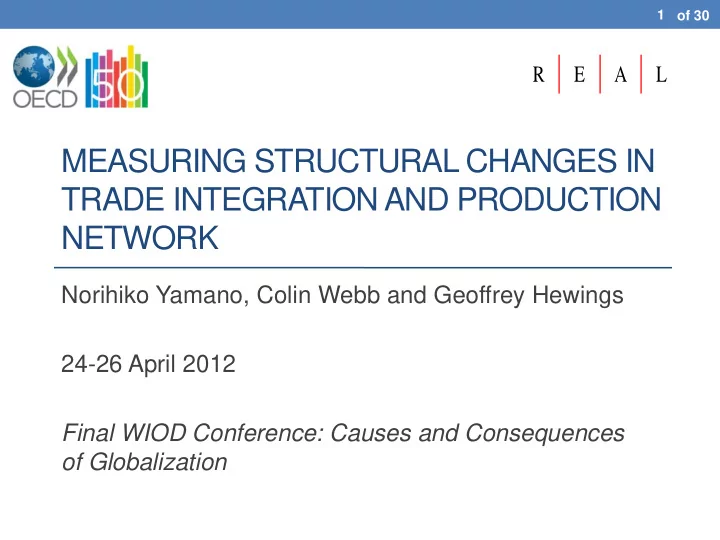

1 of 30 R E A L MEASURING STRUCTURAL CHANGES IN TRADE INTEGRATION AND PRODUCTION NETWORK Norihiko Yamano, Colin Webb and Geoffrey Hewings 24-26 April 2012 Final WIOD Conference: Causes and Consequences of Globalization
of 30 2 Contents • Introduction • Structural changes • External dependency • Economic landscape by country • Key sectors • Risk of production disruptions • Concentration of export (supply) and import (sourcing) • Dominant partner share • Forward linkages on domestic and foreign productions
of 30 3 Known structural changes in international trade and production networks • Evolution of global production networks (particularly in Asia) • Fragmentation of production processes facilitated by reduction of various transaction costs • Specialisations (comparative advantages) in specific production stages (tasks) rather than products • Increasing trades in manufacturing parts and components • Intra-industry trade Concerns of vulnerability of global value chains Disruptions of production networks are observed by the unexpected events of natural and man-made disasters (2011 Earthquakes and Flood in Asia , Toyota and Honda)
of 30 4 Fragmentation of production processes Fragmented production process (an extreme case) Final goods production in one region Foreign capital Region A’s Region B’s K - L K - L Reg A Reg C Reg D Reg B Intermediates Intermediates Imd Imd Intermediates Intermediates Imd Imd Production of Production of final goods 1 final goods 2 Final 1 Final 2 Consumer A Consumer B D A Domestic transaction B C International(interregional) trade
of 30 5 Economic theories of industry and trade • Identification of trade and industrial production activities have been always in the central issues of economics and policy planners. • For example, • Increasing return to scale and imperfect competition • Urban and regional economics: Economies of agglomeration and external • International economics: comparative advantage (Ricardo), factor endowments (H-O), intra-industry • Growth theory: endogenous growth model, regional innovation spillovers, intangible assets (knowledge/human capitals)
of 30 6 Concentration or divergence? Concentration by economies of scale Internal economies (increasing return to scale) External / agglomeration economies Localization: infrastructure sharing Urbanization: Knowledge intensive economy Divergence Constant return to scale type industries Higher transaction cost (services / heavy products) Diseconomies of scale (amenity, higher factor price) Geographical limitations on factor endowments Dispersion of risk
of 30 7 WIOD Data sources • Bilateral Trade data • Basically cover all monetary flows of cross-border transactions • Over 5200 commodities (internationally harmonised) • Previous year data is available by summer of following year • Allows us to study by end-use categories: intermediates, household consumption, capital, mixed use (personal computers, mobile phones, passenger cars, etc) • Annual Inter-country Input-Output and Supply-use tables • Explicitly links final demand, intermediate and value-added components by sector • Direct and indirect economic impacts can be measured • Fundamental data source for various global model: environment footprints, trade-in-value-added, productivity comparisons
of 30 8 Basic indicators on structural changes WIOD’s Inter-country I-Os are loaded in REAL I-O, an a generic toolbox of Input-Output (IO) analysis based on open-source architecture running on Windows XP/7 http://www.real.illinois.edu/realio/
of 30 9 Intermediate import share (Europe,100%= total inputs) (%) 45 Services Goods 40 35 30 25 20 15 10 5 0 1995 2009 1995 2009 1995 2009 1995 2009 1995 2009 1995 2009 1995 2009 1995 2009 1995 2009 1995 2009 1995 2009 1995 2009 1995 2009 1995 2009 1995 2009 1995 2009 HUN AUT SVK DNK CZE SWE PRT FIN ROM GBR GRC DEU ITA FRA ESP POL Source: WIOD April 2012
of 30 10 Intermediate import share (Other regions, 100%= total inputs) (%) 35 Services Goods 30 25 20 15 10 5 0 1995 2009 1995 2009 1995 2009 1995 2009 1995 2009 1995 2009 1995 2009 1995 2009 1995 2009 1995 2009 1995 2009 1995 2009 1995 2009 CAN MEX USA TWN IDN KOR AUS IND CHN JPN TUR RUS BRA Source: WIOD April 2012
of 30 11 Intermediate export ratio (manufacturing) World average = 56% in 2010 Source: OECD BTDIxE, 2011
of 30 12 Sector shares of output (1995 and 2009) Percent share Country Source: WIOD April 2012
of 30 13 Economic landscape (MPM) Germany (2009) Germany (2009) France (2009) FWD BWD Source: WIOD April 2012
of 30 14 China (2009) Japan (2009) FWD FWD BWD BWD Ref. Germany (2009) Source: WIOD April 2012
of 30 15 NLD(1995) NLD(2005) FWD FWD BWD BWD Ref. Netherlands(1995) Source: OECD I-O April 2012
Recommend
More recommend